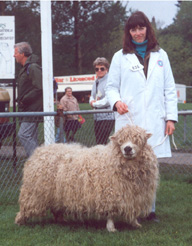
DARTMOOR OR GREYFACE DARTMOOR
The Dartmoor is also known as the Greyface Dartmoor or Improved Dartmoor although generally referred to as Greyface Dartmoors in Show catalogues.
Attractive, quiet and easily handled Dartmoors have their enthusiasts throughout the country. They provide a natural focal point whenever they appear.
Descended from the local breeds which grazed the low ground in and around Dartmoor, they have immense strength of constitution developed through withstanding the severe winters and exposed conditions which exist around the Moor. Improvements were carried out during the 19th century using the local Longwools (Notts) and Leicester.
The Association was established in 1909 to standardise, promote and develop the breed which was then established in three areas, South Brent, Chagford and Tavistock. Today flocks are kept throughout England, Wales and the south of Scotland. Breeding stock has been exported.
DESCRIPTION
The Dartmoor is classified as Lustre and Longwool.
A medium sized sheep (approx. 60 kg), hornless, deep bodied, short legged, with well woolled head and legs. The face should be mottled or spotted with black or grey with matching feet. The short straight legs are well covered with wool.
A clip of 7-9 kg can be expected with a higher yield (up to 15 kg) from mature rams. Traditionally the long, curly, lustre wool was used for blankets, serge, carpets and cloth. The wool is not coloured. Staple length 25-30 cms with a Bradford count of 36-40.
The ewes are good milkers capable of rearing twins. A lambing of about 150% can be expected with the heavy milking docile ewes rearing them quickly. Some clipping around the udder may be required to ensure easy access for the newly born lambs.
Traditionally lambs are shorn before the first of July.
SHOWS
Many County Shows provide classes for the Dartmoor. Locally most shows in the south-west have a number of individual and group classes.
REGISTRATION
Studding or inspection of all ram lambs for registration is carried out in the autumn, Only sheep passed are marked with The Dartmoor Association metal tags.
The ewe tag will have the initials DM, year of birth, flock number and unique number (e.g. DM 1996 201 12). For rams the Association 4 digit number is used. (e.g. DM 2123) with no other numbers.
(Source: The Greyface Dartmoor Sheep Breeders Association)

Janet Bullock with Rosie
HOME
TOP
PHOTOS